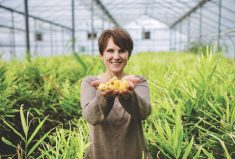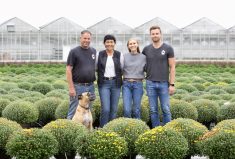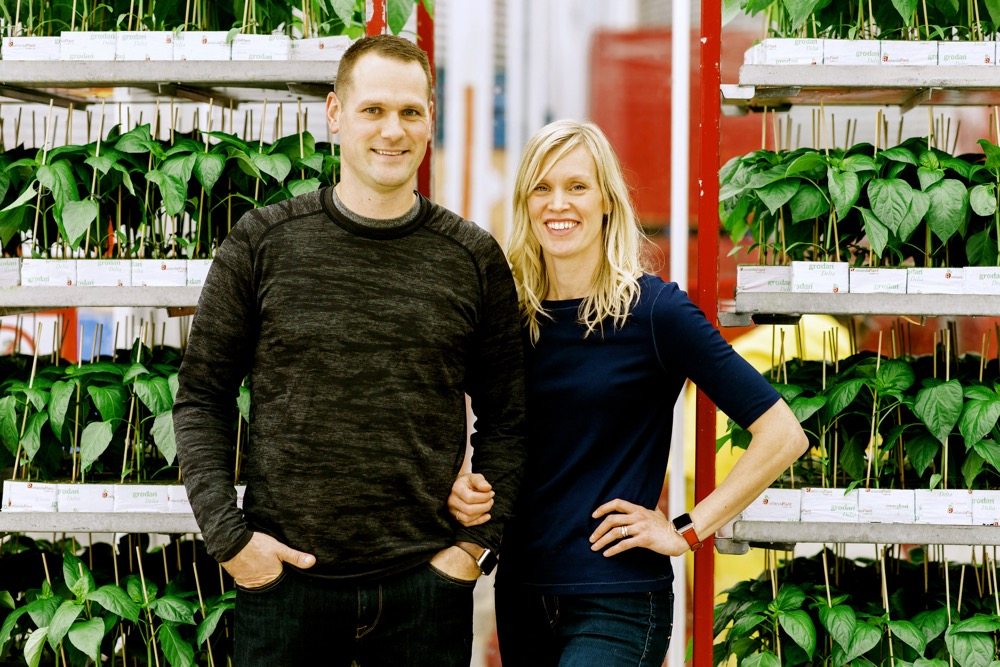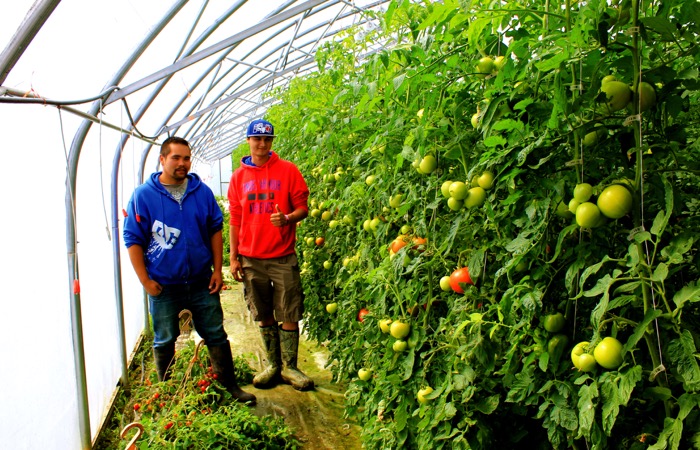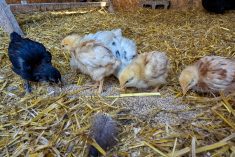Marketing experts say your farm already has a brand, and regardless of whether you give it a moment’s thought, and regardless of whether you try to manage it, that brand is your farm’s identity. It’s how you are perceived. Indeed, the people who devote their careers to thinking about these things have an even simpler way of making their point: Your farm is your brand. For most farms, your brand is conveyed by your last name — a reputation shaped and seasoned by multiple generations. The question is, can you manage your brand to give a boost to your farm business? In the case of Alberta brothers Jim and Bill Hole, their greenhouse business has been built on a brand of trust garnered by their much-loved mother. Today, the brothers’ challenge is to leverage that brand in order to build sales among time-stretched, next-gen customers. Here’s how they plan to do just that.
Winter is disappearing in a swirl of warmth and sunshine in St. Albert, on the northwest edge of Edmonton. Airseeders are poised about the countryside, and calves are nuzzling their mothers. This is the kind of day when Canadians rediscover that their heritage rises from the soil, thanks to the sweat of farm families.
Across the road, however, that heritage is taking a modern turn, and I find myself in the state-of-the-art, climate-controlled Enjoy Centre — a combination greenhouse, retail, and food outlet — where Jim Hole drinks coffee and shares the story of how his family came to build this new concept enterprise.
Read Also

Farmland values: assumptions and realities
Where farmland values are headed and what decisions farmers should make
All the while, Jim looks like he’d rather be on a tractor.
Brothers Jim and Bill Hole have been operating Hole’s Greenhouses with their parents since they graduated from the University of Alberta’s agriculture degree program in the early ’80s. Bill’s wife Valerie is the lead buyer for the greenhouse, and together they have created a booming garden business on a small farm just outside of Edmonton.
However, the brand behind their family’s success is their famous, now deceased mother, Lois.
Lois was a lieutenant governor of Alberta, and the book she wrote on growing perennials is the most popular gardening book in Canada, selling over a million copies. She even has a provincial park named after her.
That park abuts the site where three years ago her sons launched a new era in their business by building this not-so-normal greenhouse.
On the edge of the frenzy of commercial building around Edmonton, the Holes’ 242,000 square feet of greenhouse and retail lease space is 5-1/2 acres of commitment to a vision. The downstairs is dominated by an organic food store, bakery and spa. A non-stair escalator goes upstairs where customers meander between stores carrying housewares and patio furniture.
Inside, the Holes operate the trendy restaurant, event space rental and, of course, the greenhouses, and they rent out the other stores.
Customers don’t actually go into the greenhouses. Instead, plants are on display in a large retail area, and hanging baskets slide by on a conveyor.
“We’re trying to meet the needs of people who are looking for more of an experience than just a place to buy plants,” Jim explains.
The place smells like coffee, plants and baked goods — an odd combination. In its own way, it’s an odour collision that goes right to the heart of perhaps the biggest challenge behind this very capital-intensive approach to greenhouse marketing.
How do you explain a place where you’re going to encounter those three smells all at once?
It’s a new concept that some people just don’t get — and not only customers.
“The biggest challenge has been to explain the concept so folks get it and come to visit,” says Jim. “Another has been getting folks — even staff — to accept the change. If I did it again, I’d communicate to our staff, our banks, our customers better.”
Jim describes the evolution from farm to greenhouse, and then from greenhouse to large retail as a punctuated equilibrium, with three major stages. When their father Ted bought their 185-acre mixed-farming operation, his wife Lois, a Saskatchewan girl, became an avid gardener. The story is that Lois left a basket of cucumbers out in front of the farmyard and someone driving by stopped and asked to buy them.
Spurred by this demand, Ted and Lois started into fresh vegetable production on a field scale and built a road-side stand.
A few years later they diversified, and began growing their own transplants in a wooden-framed greenhouse, where they eventually also started growing flowers. Over the years, they slowly added more greenhouses, sold vegetables to big retail, and built up their successful retail garden centre.
At one point the Holes supplied a large grocery retailer with over a million pounds of carrots. However, when the margins in field crops shrank, Jim and Bill decided to focus on their burgeoning plant and flower business. In that market, they could better control the environmental risks and leverage the amazing reputation and brand their mother had nurtured.
Soon after coming home to the farm, the brothers switched to plastic inflatable tube greenhouses and they poured asphalt and concrete to make it nicer for their customers walking through their greenhouses. They professionalized their business structure with Bill as CEO and Jim maximizing his passion for plants. The greenhouse business flourished.
“When Bill and I started farming it was easier,” Jim now says. “There were lower expectations and lots of latitude to try new things, to learn.”
More from the Country Guide website: Time for a radical change
The ’90s brought an onslaught of big box stores selling plants. Soon, home building centres and grocery stores also infiltrated the business. The new reality for younger customers became those temporary garden centres plonked down for a few months every year in some corner of a mall parking lot.
More recently, there’s a trend toward pay-by-scan — technology that downloads the cost and labour of maintaining inventory to growers.
“It’s a whoever-blinks-first business now,” says Jim.
It isn’t the business that the Holes wanted to be in, or a business where their brand could easily help them rise to the top. Instead, the business was becoming all about competing for grocery shelf space with farmers from around the world.
“Today vegetables and plants are treated like commodities, with volume sales produced and sold as cheaply as possible,” says Jim.
Their parents have been gone for quite a few years now, and the Hole brothers have moved the operation off of the home farm, but they still only sell plants they grow themselves, and they still stress service.
Together, they also decided that their their plant quality and their focus on sharing their knowledge with customers can meaningfully differentiate them from the big box stores.
The Holes have changed their operation to meet the demands of a changing demographic. The younger generation doesn’t garden as much and many think that buying plants in the chain store is the only way to get them, says Jim. Yards are smaller, and fewer are gardened.
That raises an additional hurdle. One problem with being considered experts, Jim points out, is that the younger generation can be too intimidated to come to the Holes to buy plants. It’s sort of like just wanting to buy a bottle of wine. Would you really go to a store with hundreds of labels, and where you might get asked all kinds of questions you can’t answer, or would you rather go someplace where you can simply pull a bottle with a cool-looking label off the shelf?
So the challenge is, how do you get novice gardeners to overcome their resistance?
For the Holes, the answer is to invite them for coffee, a trip to the spa, and shopping. “We’re changing that by making the experience less intimidating, even welcoming,” says Jim.
The basic idea of the Enjoy Centre is to reflect, relax, and reconnect. The trick, however, is to convince the general public that relaxing and gardening go together. The other challenge is to have customers understand that this is a year-round facility with other stores, basically a mall with a greenhouse attached. The greenhouse retail area converts to a beautiful event space after the spring sales are done. Hosting events, such as an artisan craft show, increases traffic flow.
Now, three years into this venture, they’ve already rotated retail displays and the spa ownership. Recently they’ve hired a consultant to help rework their restaurant. “We’re staying the course, with some constant tweaking,” says Jim.
The part customers don’t see, even though it’s the backbone of their operation, is the high-tech Dutch-style greenhouse complex. The floor watering system uses rainwater and snow melt collected in pits below the building and has an automated hanging basket watering system.
Jim is the self-proclaimed new face of the business. He has his own products named “Jim Hole” garden tools. He’s a guest on local talk radio and a sought-after speaker on gardening and plant science.
Today, Jim believes that learning to become a brand was something he managed to absorb from his mother simply by being around her.
The science of branding seems to be behind them. In the 1990s, Marshall Duke, a psychologist at Emory University, found this sharing of family stories not only creates a family brand but also often helps create successful individuals. Children who know a lot about their families, especially the ups and downs, tend to do better when the going gets tough.
It turns out that one of the most important things you can do for your children may be to tell family stories. Self-confidence is linked to having a strong inter-generational self and knowing you belong to something bigger than yourself. Then, when you face challenges, you are adding a new chapter to a story that already has other stories about how other family members overcame similar difficulties.
These stories become traditions and what New York author and family business consultant Phyllis Weiss Haserot calls a family brand. Brand is the consistent experience suppliers and buyers expect when interacting with the family or company, she says. “Brand should be consistent with mission and vision statements but is much more. It’s a combination of reputation, personality, and first-hand experience.”
With a strong family brand, successors should have a sense of what’s expected. However, that doesn’t necessarily make succession easy, says Weiss Haserot. Family dynamics and individual ideas can influence how well succession plays out and they may need outside neutral advisers to help them reach consensus on a plan.
Jim continues to share the Hole family narrative on his radio show and in his many public presentations. He believes that this Hole brand will carry customers through the doors of the new facility, and that it will help the family create a new generation of loyal customers buying direct from greenhouse growers.
“I learned from Mom that it’s not just about facts, people want the narrative,” says Jim. “Wrap it in a story, make it genuine and real.”




